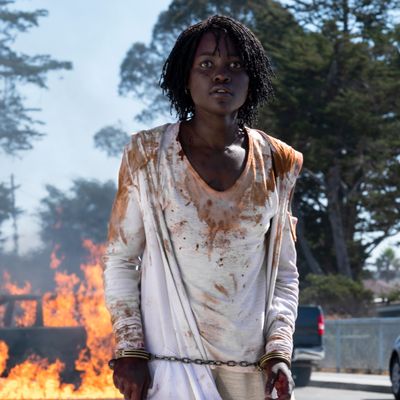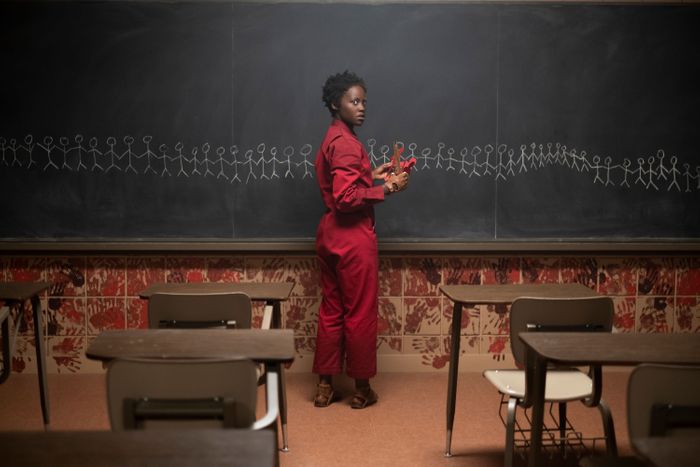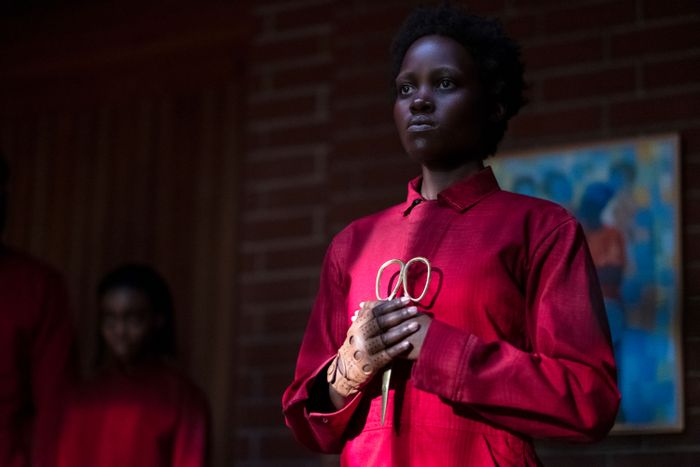
Jordan Peele has a real gift for parting shots. Daniel Kaluuya’s Chris surviving at the end of Get Out, the flashing lights of law enforcement serving as his salvation instead of his death sentence, is layered with enough subtext to suck the air out of a room — if it hadn’t pushed audiences to triumphant ovations instead. The writer and director similarly packs the finale of his sophomore feature, Us, with both social and metatextual commentary. Horror, like all of cinema (and so many workplaces), has a diversity problem, so the image of a luminous, dark-skinned black woman as the surviving heroine is still a kind of revolutionary act for a highly promoted studio picture in 2019. But a whole lot happens in the final minutes of Us to wrap that last look up in a bow, so let’s unpack the exhilarating sprint to the finish in Peele’s new movie.
But first, the groundwork. The scope of Us touches on possibly every person in America, but for the purposes of Peele’s film it focuses on the Wilson family, a husband and wife with two children who are setting out for a vacation in Northern California. From the start, Lupita Nyong’o’s Adelaide Wilson has an uncanny feeling. Something’s not right. In flashbacks, we learn that the vacation returns her to the site of a bizarre childhood trauma, where she once saw a mirror image of herself she can’t forget. Because of that, she’s reluctant to venture anywhere near the beachside amusement park of her memories. She spends most of her first day in a perpetual state of worry, fretting over her children’s whereabouts and ignoring their hapless white friends on vacation at the same time. That night, her suspicions about impending danger prove correct when a mirror image of her family shows up in their driveway and stages a terrifying home invasion. These are the Shadows — a kind of darkest timeline version of the Wilsons — and they’ve emerged from an underground world to claim the lives of their dumbfounded doubles.
From that point, Us becomes a game of predator and prey. The Shadows set upon annihilating their doubles with their scissors; the doubles perform feats unimaginable in order to survive. The hapless white couple dies. Their equally hapless Shadows perish, too. After a relentless boat duel, a morbid sprinting contest, and a lot of Lupita-on-Lupita exposition, the Wilsons learn that it’s not just their little corner of Santa Cruz that’s vying for survival against evil doppelgängers. A horde of Shadows, all bizarre copies of humans across the nation, who dress in red coveralls and leather fingerless gloves, have risen up from places unknown to wreak havoc on their identicals and claim their place on the surface. The Shadow named Red, the mirror image from Adelaide’s past, just happens to be their leader.
By the time we reach the film’s final gasps — a violent ballet performed by two warring Lupitas in a basement below the amusement park, that produces almost the inverse emotional effect of Annihilation’s stunning finale from last year — we know what’s been motivating Red all along: Adelaide was actually born a Shadow. She spent her early years growing up in the underground world of tethered clones before she forcefully traded places with the real Adelaide at a beach in Santa Cruz and assumed her identity above. But the raised scars of living in a world without a sky never faded, just as trauma never really leaves a person. The fear of poverty or hunger or abuse or captivity or neglect sits in a toxic waste drum in your mind that’s liable to start leaking at any moment. And when it does, no amount of creature comforts will protect you.
We see that leak in Adelaide’s eyes as soon as she wakes up on the family’s road trip, and it intensifies when her husband, Gabe (Winston Duke), insists on going to the beach — the beach, that sits atop a portal to her past. Even if she doesn’t know exactly what’s coming next, Adelaide feels the threat of her origin point growing stronger, a place where people have no voices to scream and have to cut their own children from their bellies in childbirth. She’s petrified when her son drifts away from the family, even though she’s unaware of exactly what he saw outside that beachside fun house.
After the Wilsons return to their vacation home, Adelaide stares out her bedroom window and into her reflection, revealing an early hint of her true identity. As she recounts the events of the night she got “lost” as a child in the very same fun house, Adelaide’s voice trembles with a terror reserved for people who know exactly what hell looks like. She may not know when her Shadow will arrive to take her, but she knows exactly what she’d be taken back to — and it’s a place she’s already done everything necessary to escape once before. When the vengeful Red finally appears outside the Wilsons’ home with her doppelgänger brood in tow, an inevitable transformation of character begins.
There’s a buffet of potential metaphors baked into Us. You have the disenfranchised dwelling invisibly below the surface, the results of some abandoned experiment that’s never quite explained, while the privileged live in ignorance above, much like the exaggerated divides in science fiction works that feature the poor scraping by on streets far below cities in the sky (Elysium, Altered Carbon, Alita: Battle Angel). You have a lower class powered by faith in a higher calling, who incite violent revolution with religious zeal. (Us begins as a home-invasion horror, but eventually morphs into a sort of nationwide zombie thriller; the tethered across America rise up to take what’s theirs.) With so much Regan-era imagery — Hands Across America, VHS tapes of The Right Stuff and C.H.U.D. — it could even read as a commentary on the success and failures of Gen X policy-making.
Us is a real Choose Your Own Adventure kind of critique, and your mileage may vary on how fully you believe it elucidates any one of its potential messages. But if you take the view from 30,000 feet, the ending of Peele’s film shows us for certain that delineating between us and them is as impossible as it is useless, especially since the definition changes depending on what side of the mirror you’re standing on.
The ending itself happens fairly quickly. By the time Red and Adelaide converge for their final dance of death, we see two women equally desperate to reclaim their lives. Both are mothers and wives. Both have killed to survive, and both are fighting to live as the person instead of the tethered. But their differences abound. Adelaide was able to “pass” as someone who belonged above ground. She became an elite dancer, married a handsome man, loved her two children, even hobbled her way into the bowels of the fun house — a portal to the tethered world — to rescue one of them. Red, meanwhile, was snatched from her life in the sun and handcuffed to the darkness. She lost her voice, ate raw rabbit, married a brute, and gave birth to monsters. Being born above did nothing to insulate her from the horrors of the underground. She may not have been born a test rabbit, but she became one after being thrown in a cage.
When Adelaide finally overcomes her adversary, defeating Red in a highly choreographed duel and cutting the tether at last, we see Red whisper an inaudible something, and the line between us and them disappears. “Other” is just a matter of perspective, a designation made up by people in power to reinforce their dominance. Privilege is not a product of some noble destiny; it’s just an accident of birth. (Even in her tragic circumstances, however, the status Peele gives Red should not be overlooked. We don’t often see little black girls tapped by their communities to be revolution leaders in studio films, horror or otherwise.)
And so we return to the film’s closing shot. A bloody Adelaide is driving her family to nowhere in particular, but anywhere that’s far from the Santa Cruz boardwalk. We cut away to a wide shot of red-suited men, women, and children with their hands clasped and forming an expansive human chain across the landscape. Helicopters circle ahead. Thanks to Adelaide, the Wilson family members are safe for now, but each is aware that you’re never really out of danger when the villains look just like us. A steady parting glare from Adelaide’s son, directed at a mother he might no longer recognize, says as much.




